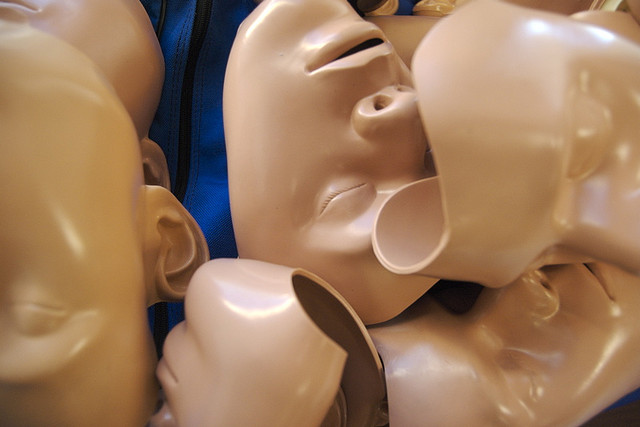A Comprehensive Guide For People Who Are Currently Drowning
This is an abridged comprehensive guide on what to do in the event that someone you’ve long admired starts to drown

This is an abridged comprehensive guide on what to do in the event that someone you’ve long admired starts to drown. If the victim has already been evacuated from the water, please refer to our other procedural primers:
1. How To Perform CPR
2. How To Ask The Person Performing CPR To Kindly Stop Since It Appears As Though The Victim Is Dead
3. How To Stay Focused On Administering CPR Despite Another Person’s Negative Tone, Because All You Have Left Is Faith
4. What To Say To The Delusional Person Performing CPR Whose Persistence, Despite Good Intentions, Is Seriously Starting To Embarrass Everybody
5. How to Ignore the Person Yelling At You To Stop CPR, Because You Instinctively Know It’s Not This Victim’s Time To Die, Not If You Have Anything To Say About It
6. How To Lean Back Quickly When The Victim Starts Sputtering Up Water So You Don’t Get Their Germs On You
7. How To Act Toward The Losers After It’s Proven That Your Hope Was The Correct Way To Feel All Along
Using This Manual
Peruse or skim this manual as a precautionary measure before setting off on any potentially perilous seafaring journeys. Also, when swimming, carry the manual with you—preferably in your back pocket—and take it out for reference if and when you begin to “drown.” It also makes for great light-reading material during an actual drowning while you are waiting for help to arrive.
Signs That You Are Drowning
Most people have never drowned to death in their whole lives. When faced with drowning, consequently, it’s hard to tell if you might be on the verge of death or if you’re just making mountains out of molehills. For starters, don’t self-diagnose. Find a qualified medical professional to do that instead. This ensures you aren’t alarming everyone without just cause. It’s the same principle behind not yelling “FIRE!” in a crowded theater that’s on fire. You wouldn’t want people getting hurt by your careless words and the fire.
NOTE: As a drowning person, it is a good thing to appear to be flailing profusely rather than looking lifeless or unconscious, as this type of behavior will attract attention from the wrong crowd.
Drowning in Progress
It is no longer de rigueur to call a drowning person “air deprived,” since this implies that, without certain gases, that person is incomplete. The correct term now is: oxygen challenged.
If you are oxygen challenged, try not to panic. Calmly state your worries to other people in the vicinity. Saying things like, “Glug, glug, glug…” may feel like the easiest thing to utter, but taking a more direct and detailed approach greatly increases your odds of being saved.
Bring attention to the situation by hand clapping a few times and clearing your throat. “Excuse me, may I please have your attention? It appears as though I am no longer swimming but in the process of drowning. Is it possible—I don’t mean to bother any of you, really, I don’t—for someone to jump in and save my life? … Sirs?”
NOTE: Offering a monetary reward is recommended, as people generally respond faster to a cash incentive than to episodic future identification with an abstract concept, like heroism.
Life After CPR
Life immediately after CPR is administered can be quite confusing and frightening. Oftentimes, you feel lightheaded, disoriented and are invisible. This is all very normal, and it simply means that the CPR didn’t take hold. Gather your strength, making sure to leap clear out of your body and into the next dimension. Do not try to take valuables with you, such as interesting rocks you found that day, as you have no pockets. Follow the light.
The best way to tell if CPR worked is by opening your eyes and breathing on your own. Don’t forget to ask if the people gathered around can “see” you. If people say, “No, no, we can’t,” please refer to the preceding paragraph.
Post-rescue, you may experience survivor’s guilt. This is common, especially if all the people who died on the boat that day were quite charming and, at some point, you were rude to one of them.
NOTE: CPR is only one of many treatment options available to a victim. Please read “CPR vs. Homeopathic Remedies” for more details about the differences between Western medicine and holistic approaches to life-saving techniques. While CPR tends to be more effective as a means to not dying, a homeopathic resuscitation treats the whole body, including your chakras, and is careful not to focus too much on your heart and waterlogged lungs.
Always Remember Your CBCCs: upon regaining consciousness, don’t forget to Cough, Breathe, Cough, Cough!
Other Helpful Pamphlets: “Understanding Emergency Sign Language: The Universal Heart Attack Signal”
In this primer, we explain the often complicated but foolproof way to communicate that you’re having a heart attack! … Three fingers laid crosswise to the ribcage with the forefinger directly perpendicular to the fourth rib from the top. Victim will tap on nose six times with the left hand to officially signal heart attack officially in progress. ![]()




